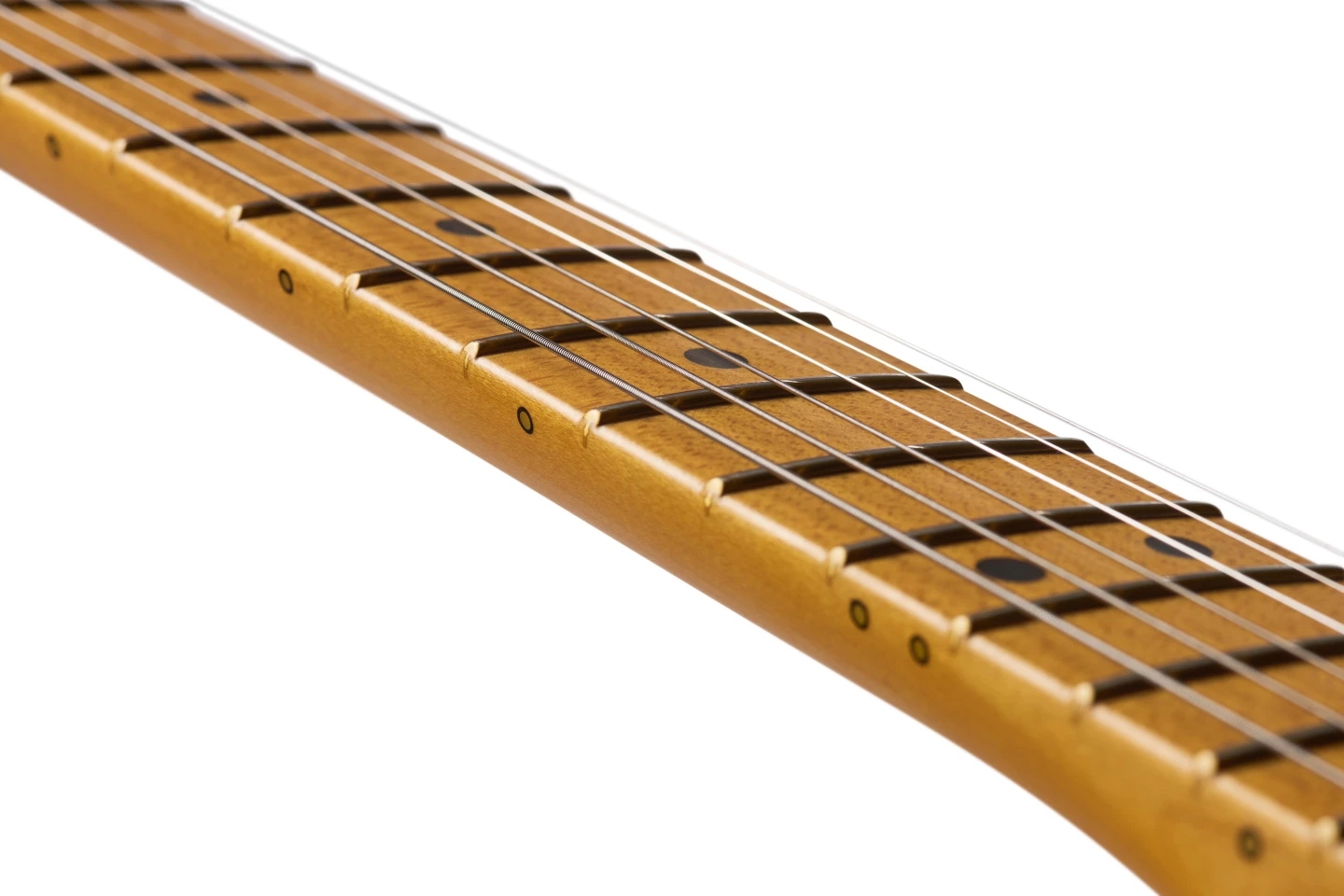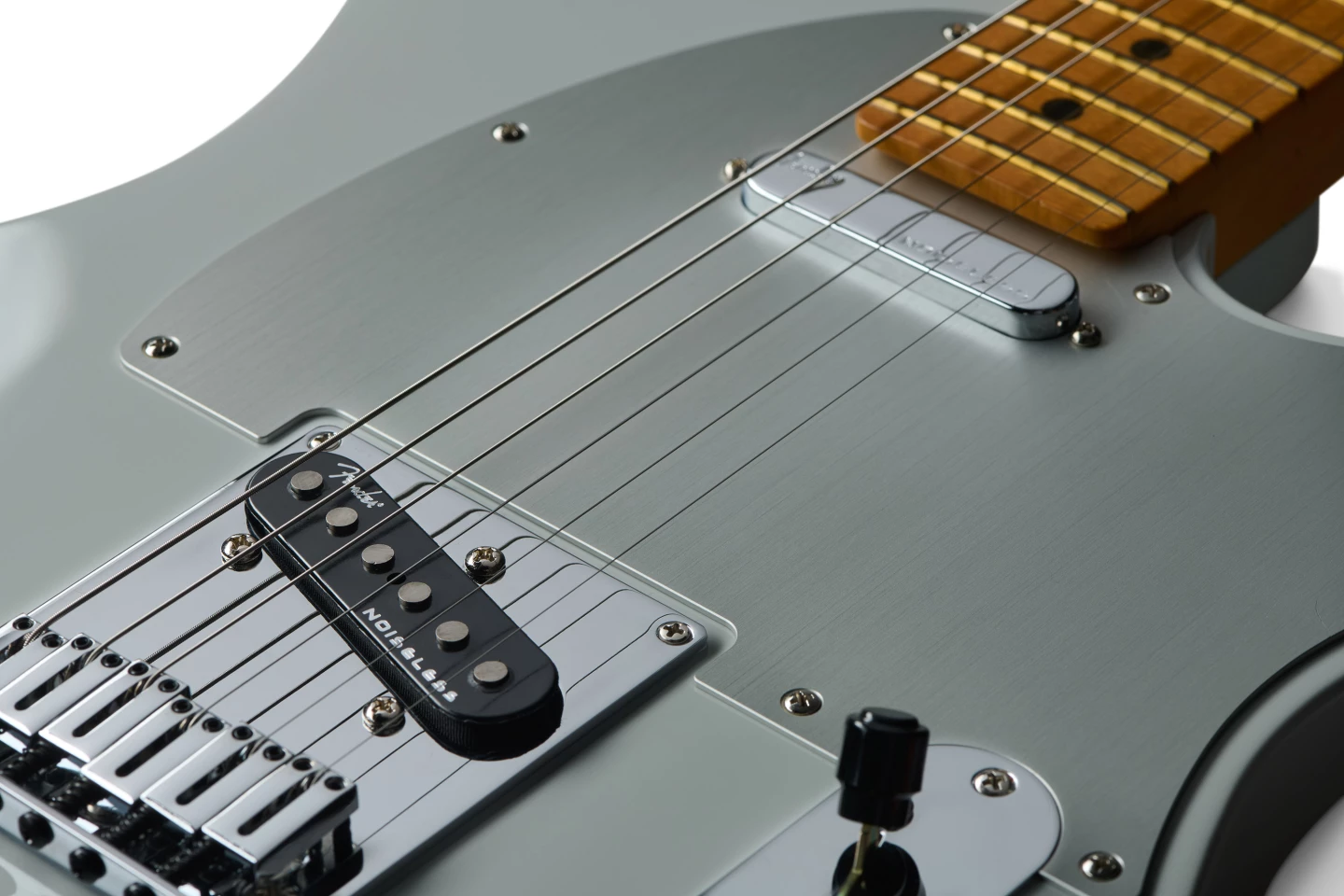You could argue that the American Ultra II is a blasphemy against the purity of Leo Fender's first masterpiece – or you could evaluate this guitar without the baggage of its heritage. Either way, it's certainly a fascinating and inspiring instrument.
My first electric guitar was a Fender Telecaster, and I did my shopping based largely on a single video by ridiculously talented jazz/bluesman Josh Smith, who swept me up in his boundless enthusiasm and love for vintage-style Teles.
"There's something magical about this guitar," he told All Guitar Network. "When Fender built this guitar in '49, '50 ... It's almost unchanged today ... It's a thick body. It's not comfortable. It's sharp on the edges. It has three saddles for six strings, so intonation is not perfect. But it's part of the charm, and part of the attributes that add up to make this thing explosive and dynamic. I truly, truly think it's the best electric guitar ever made, and the one that can do it all."
Righto, thought I, and went and bought something that stayed relatively close to the original recipe: an American Professional dated around 2018. Butterscotch, blackguard, three brass saddles, single coils and a plank of a body with basically zero regard given to ergonomics. And it's been a hell of a guitar – solid as a rock, beautiful to play, slightly hard work, but it sounds gorgeous, and is certainly surprisingly versatile across a range of different styles.
Meanwhile, the brand-spanking-new American Ultra II (aptly demonstrated below by Mötley Crüe/Rob Zombie/Marilyn Manson/David Lee Roth guitarist John5) smooths off all the hard edges to which Josh Smith attributes that vintage Tele charm.
For starters, belly and arm carves on the front and back of this alder body nudge the main ergonomic touchpoints toward Stratocaster territory. It doesn't feel nearly as planky. Even the neck heel is smoothly contoured, with a gorgeously swoopy-looking neck heel carve that's frankly a pity to hide at the back of the instrument; only the fancier Strats get that kind of treatment.
The three brass saddles are gone, replaced by six (again Strat-style) chromed brass block saddles – so that in-betweeny vintage Tele intonation is replaced with individual-string precision.

The quartersawn maple neck uses a 'Modern D' shape in a satin finish, complete with glow-in-the-dark side dots, locking tuners and a self-lubricating Tusq nut as opposed to the traditional bone.
The ebony fretboard (or maple on other versions, as in the photos here) gives you a compound radius – 10 inches down in the lower frets where the money is, 14 inches up where things get twiddly and diddly. So it's a little rounder and more comfy for chordal playing down near the nut, but a little flatter, and subsequently better for bending and shredding on those jumbo frets as you move up toward the high notes.

Then there's the electronics; they might look just like single-coils, but the Ultra II Noiseless Vintage Tele set installed in this thing are, to my understanding, more like miniature stacked humbuckers in design.
And the controls look nearly the same as an old-school Tele – apart from a rakishly angled pickup selector – and they work nearly the same, but there's a sneaky button hidden in the top of the volume knob that engages both pickups in series, no matter where the selector's pointed, and acts as a kind of boost button as well as a fourth tonal option.
Add to all that a rich Texas Tea paint job that sparkles like the fizz of Coca-Cola under lights, an anodized aluminum pickguard and a set of Schaller-style strap locks included in the case, and the Ultra II is an unashamedly modernist, if pleasantly visually understated, take on the traditional Tele.
Below, you can watch a bunch of the Fender brains behind the line, plus YouTuber Rhett Schull, discussing a lot of the ideas and techniques behind the Ultra II series and playing the guitars through a range of tones, set against the backdrop of the storied Fender factory in Corona, California, where I was lucky to take a tour earlier this year as part of the 70th Anniversary of the Fender Stratocaster.
So how does this new Telecaster go?
One thing's for certain – the Ultra II Tele is an absolute joy to play. All those modern curves and comforts definitely make it a more friendly shape to rest against my highly curved and comfortable human body, standing up or sitting down.
That satiny neck just gets right out of the way – I'm definitely a fan of the compound radius, it gives me just what I want, right up and down the fretboard, and without touching the setup out of the box, it's just about spot on, allowing super-extravagant vibrato and fourth-interval bends up high without choking the note.
If you like to fight a guitar – and plenty of people do – this might not be for you. More than once I've felt like it might actually be playing itself on my behalf, and that's a sentiment I've had echoed to me by friends who've spent some time with it as well.

It's difficult to make an apples-to-apples comparison here against my AmPro, since that's strung with meaty 10-52 light top/heavy bottoms, where the Ultra II ships with positively dainty 9s – another step away from Josh Smith's preferences, incidentally, as that lunatic masochist uses Danny Gatton-style 13-gauge forearm-busters.
So the playing experience is quite different, and that in itself does change the sound and volume between these two guitars. Swap strings and my AmPro is going to feel a lot easier, and the Ultra would feel like you could beat it up a lit more.
Sonically, with a bag over my head and forced to choose, I'd say the AmPro might just edge it on clean and breakup through to overdriven tones, where there's a hint more of that hollow, bottley harmonic complexity in the neck pickup, and a touch hotter output. But that's by no means a sure thing this time; the Ultra's new pickups are the best 'noiseless' set I've played yet.
They're downright sparkly in the trebles, where some previous noiseless pickups have felt a step behind true single coils. They're super dynamic, punchy and touch-sensitive, the bridge pickup can snarl, twang, spank and rip faces off in all the right places, and neither the bridge or neck would've struck me as anything but a genuine single-coil if they didn't have "Noiseless" written on them.

The noise-busting part itself works really nicely – but then, you've got to dial in some pretty heavy gain before that becomes a huge problem. I'd say you can go a fair way into hard rock territory with an American Professional before you'd reap a really significant noise-floor reward there from the Ultra II – but it's a testament to the versatility of the Tele that these instruments are definitely finding their way into a range of high-gain situations as well as cleaner territory like country, jazz, funk, blues, pop and ... whatever the hell it is that Julian Lage does.
The S-1 switch in the volume knob is a handy addition. It doesn't matter which position you're in, you can hit that thing and be rewarded with a solid jump in output, as well as a thick and beefy fourth tone option that fills in more or less whatever's missing from the position you're in.
From the bridge, you get a lot more low-end punch, from the neck, you get that top-end sizzle, and from the middle, you get a lot of extra body and sustain. It might not be a traditional Tele sound, but I can't see anything but positives in the way it's been added.
As to the rest of the controls, I often find myself wishing more guitars worked the way these two Teles do. One nice, consistent volume knob with a treble bleed circuit, so you don't lose high end when you want to ease off the output a little. One tone knob that's effective whichever pickup position you're in. One little rubber knob that's gonna make a break for freedom at the first available opportunity, but which you can buy replacements for by the dozen ... It's a great setup, quick to learn, lifetime to master, all that good stuff.

My one complaint here is that the tone knob on the Ultra II has a detent that makes it a slight effort to rotate away from wide open. Teles being Teles, the bridge pickup in particular can be pretty harsh on the ear with certain amp settings, so that tone knob can get a workout. The detent doesn't seem to help much, since the knob's way back behind the bridge and not likely to get knocked accidentally – and it makes a pinky finger tone adjustment unnecessarily hard and clumsy in my opinion.
Indeed, that might be about the only solid negative I'd put forward when it comes to the Ultra II Telecaster; a knob you can probably switch out with 10 bucks and a soldering iron – and that's if it even annoys you.
Otherwise, this feels every bit like a luxury version of a Tele, pampering the player at every chance with rolled edges, comfort carves, compound radii and proper intonation, and bucking some amplifier hum while making a negligible tonal sacrifice next to a single-coil AmPro.
It sounds great, it's stunningly easy to play, and the aesthetic choices made here, like the clean, modern flat bridge plate instead of the old 'ashtray' bridge, move things forward in an understated way that feels both progressive and respectful.

As a flagship model it's unapologetically pricey; it'll cost you US$2,199 (or AU$3,799 in Australia) – certainly toward the hefty end of the Telecaster range, without getting anywhere near Custom Shop dollars. In terms of case candy ... There's not much, but the Fender Deluxe flight case itself is pretty sweet in its own right, a molded-plastic Samsonite creation with a fuzzy interior, gear storage compartment and a set of TSA-friendly locks, to go with its thoroughly roadworthy exterior.
Compared to the outgoing Ultra-series Tele, the chief visual difference between the two will be the angled pickup selector knob, as well as the lack of a top binding. So the older model might be worth a look if you're a fan of that look. Less-apparent upgrades include the new pickups, Luminlay side dots and Tusq nut, but otherwise the older model's got most of what makes the Ultra II so easy to work with.
So yes, this machine might struggle to win over purists – but Fender already spends an extraordinary amount of time and effort catering to purists, with vintage reproductions available at every imaginable price point.
But it's a beautiful, flexible, approachable and inspiring instrument in its own right. And that fast 'n' furious neck, the noiseless pickups and built-in S1 boost switch make the elegant simplicity, classic look and extraordinary flexibility of Fender's first masterpiece relevant deep into the Telecaster's seventh decade and beyond.
There are other new Ultra II series Fenders, including a Strat, a P-Bass and a J-Bass, which you can see in the video below.
Source: Fender





















